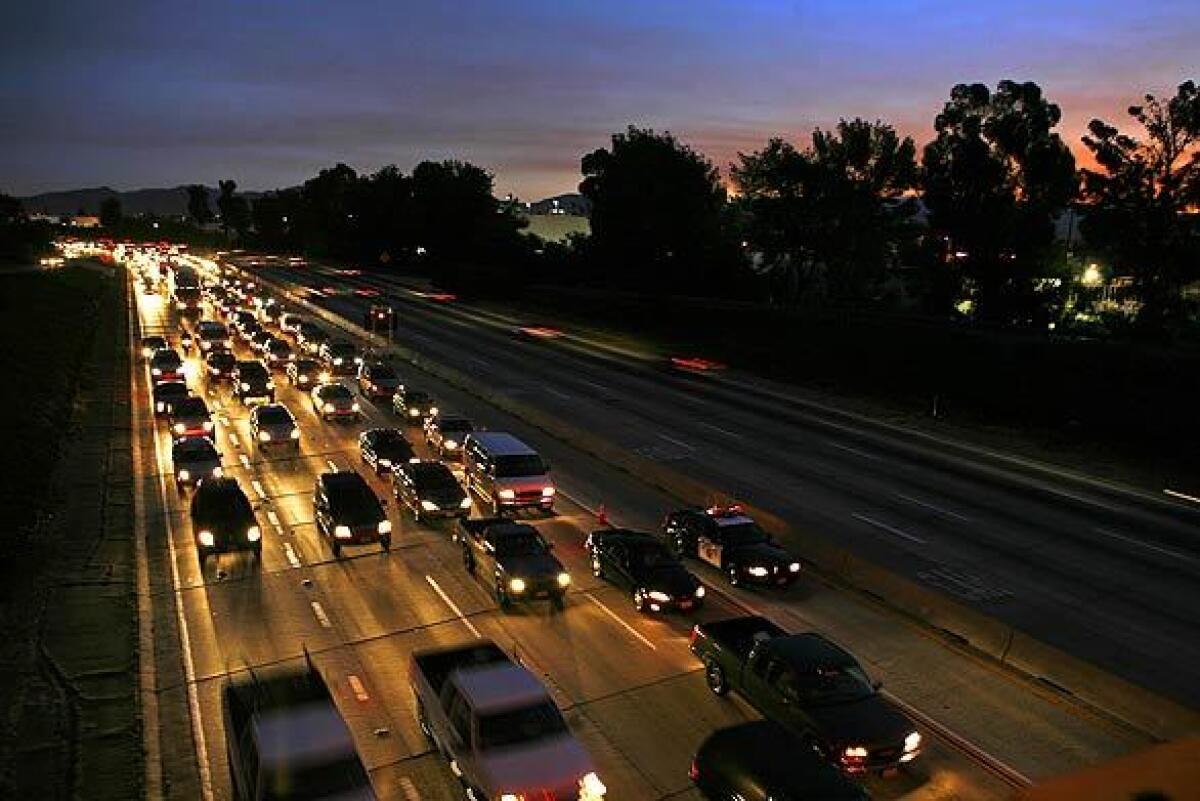Los Angeles County will study toll lanes on the 405 Freeway

- Share via
Los Angeles County transportation officials will study whether drivers who are alone in their cars and are willing to pay a toll should have access to the 405 Freeway’s carpool lane through the Sepulveda Pass.
The Metropolitan Transportation Authority on Thursday hired the engineering firm WSP USA Inc. to study how to convert the 405’s carpool lane into a toll lane that would grant access to single-occupancy drivers, for a fee.
For the record:
11:40 a.m. Dec. 6, 2019An earlier version of this article identified Shahrzad Amiri as a deputy executive officer for Metro. She is an executive officer.
The toll lanes would run between the 101 Freeway in the San Fernando Valley and the 10 Freeway in West L.A.
The three-year, $27.5-million study will examine whether the toll route should have one or two lanes in each direction, and what Metro should charge solo-occupancy drivers who want to use them.
If Metro’s directors approve the toll lanes, they would open to drivers in the fall of 2027, just before Los Angeles hosts the 2028 Summer Olympics, officials said.
The toll lanes are being developed in concert with a rail line that will connect the Valley to the Westside. The project, either a subway or a monorail, has an estimated price tag of $9.4 billion to $13.8 billion and calls for a tunnel as long as 13 miles through the Santa Monica Mountains.
The line is slated to open between 2033 and 2035. Los Angeles Mayor Eric Garcetti and other elected officials on Metro’s board have pushed to complete the mega-project in time for the Olympics.
The operation of the 405 toll lanes would be modeled after the ExpressLanes on the 110 Freeway between Exposition Park and the South Bay and the 10 Freeway between downtown and El Monte.
Drivers who are alone in the car and enter the toll lanes are charged a per-mile rate that starts at 25 cents and rises as high as $2.10 as congestion in the paid lanes grows worse. The maximum total toll is $23.10 on the 110 and $29.40 on the 10.
Metro is also soliciting a study of how much drivers would be willing to pay, which will help set the tolls for the 405 corridor, said Philbert Wong, a senior manager of transportation planning at Metro.
The $1.6-billion widening of the 405 added a single carpool lane in each direction through the Sepulveda Pass. Engineers will study the available space on the freeway to determine whether Metro could squeeze in a second lane for tolled trips by using auxiliary areas or narrowing the existing lanes.
“It’s going to identify additional right-of-way within the current footprint,” said Metro executive officer Shahrzad Amiri.
The 405 will not be widened again to accommodate the toll lanes, she said, and Metro will not convert any existing general-purpose lane into a toll lane.
If there proves to be space for only one toll lane in each direction, Caltrans would increase the occupancy requirements for carpooling on the 405 to three people per vehicle, spokesman Marc Bischoff said in an email. Under that policy, a driver with one passenger would be required to pay the toll.
Ending free rides for two-person carpools would affect more than half the vehicles that use the 405’s carpool lanes during rush hour, according to a study prepared for Metro in 2016.
The policy change would be aimed at keeping speeds in the lane above 45 mph at least 90% of the time during peak periods, a requirement for all toll lanes and carpool lanes that receive federal money.
No stretch of the 405 carpool lane in Los Angeles County met that standard more than 25% of the time in 2017, according to the most recent data available from Caltrans.
The 405 project has $260 million earmarked through Measure M, the sales tax increase that voters approved in 2016. The funding will be available starting in 2024.
Metro is also planning to convert the 105 Freeway’s carpool lane into a toll lane between the 405 and the 605 Freeway by 2025.
More to Read
Sign up for Essential California
The most important California stories and recommendations in your inbox every morning.
You may occasionally receive promotional content from the Los Angeles Times.














